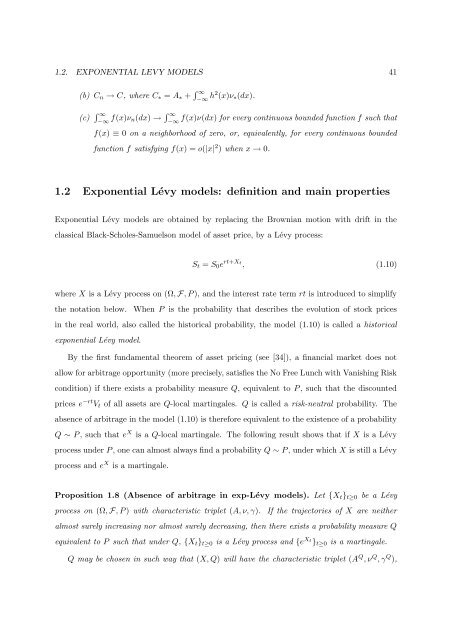Processus de Lévy en Finance - Laboratoire de Probabilités et ...
Processus de Lévy en Finance - Laboratoire de Probabilités et ...
Processus de Lévy en Finance - Laboratoire de Probabilités et ...
You also want an ePaper? Increase the reach of your titles
YUMPU automatically turns print PDFs into web optimized ePapers that Google loves.
1.2. EXPONENTIAL LEVY MODELS 41<br />
(b) C n → C, where C ∗ = A ∗ + ∫ ∞<br />
−∞ h2 (x)ν ∗ (dx).<br />
(c) ∫ ∞<br />
−∞ f(x)ν n(dx) → ∫ ∞<br />
−∞<br />
f(x)ν(dx) for every continuous boun<strong>de</strong>d function f such that<br />
f(x) ≡ 0 on a neighborhood of zero, or, equival<strong>en</strong>tly, for every continuous boun<strong>de</strong>d<br />
function f satisfying f(x) = o(|x| 2 ) wh<strong>en</strong> x → 0.<br />
1.2 Expon<strong>en</strong>tial Lévy mo<strong>de</strong>ls: <strong>de</strong>finition and main properties<br />
Expon<strong>en</strong>tial Lévy mo<strong>de</strong>ls are obtained by replacing the Brownian motion with drift in the<br />
classical Black-Scholes-Samuelson mo<strong>de</strong>l of ass<strong>et</strong> price, by a Lévy process:<br />
S t = S 0 e rt+Xt , (1.10)<br />
where X is a Lévy process on (Ω, F, P ), and the interest rate term rt is introduced to simplify<br />
the notation below. Wh<strong>en</strong> P is the probability that <strong>de</strong>scribes the evolution of stock prices<br />
in the real world, also called the historical probability, the mo<strong>de</strong>l (1.10) is called a historical<br />
expon<strong>en</strong>tial Lévy mo<strong>de</strong>l.<br />
By the first fundam<strong>en</strong>tal theorem of ass<strong>et</strong> pricing (see [34]), a financial mark<strong>et</strong> does not<br />
allow for arbitrage opportunity (more precisely, satisfies the No Free Lunch with Vanishing Risk<br />
condition) if there exists a probability measure Q, equival<strong>en</strong>t to P , such that the discounted<br />
prices e −rt V t of all ass<strong>et</strong>s are Q-local martingales. Q is called a risk-neutral probability. The<br />
abs<strong>en</strong>ce of arbitrage in the mo<strong>de</strong>l (1.10) is therefore equival<strong>en</strong>t to the exist<strong>en</strong>ce of a probability<br />
Q ∼ P , such that e X is a Q-local martingale. The following result shows that if X is a Lévy<br />
process un<strong>de</strong>r P , one can almost always find a probability Q ∼ P , un<strong>de</strong>r which X is still a Lévy<br />
process and e X is a martingale.<br />
Proposition 1.8 (Abs<strong>en</strong>ce of arbitrage in exp-Lévy mo<strong>de</strong>ls). L<strong>et</strong> {X t } t≥0 be a Lévy<br />
process on (Ω, F, P ) with characteristic tripl<strong>et</strong> (A, ν, γ). If the trajectories of X are neither<br />
almost surely increasing nor almost surely <strong>de</strong>creasing, th<strong>en</strong> there exists a probability measure Q<br />
equival<strong>en</strong>t to P such that un<strong>de</strong>r Q, {X t } t≥0 is a Lévy process and {e Xt } t≥0 is a martingale.<br />
Q may be chos<strong>en</strong> in such way that (X, Q) will have the characteristic tripl<strong>et</strong> (A Q , ν Q , γ Q ),
















